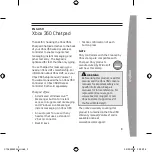
90
PLZ-4WH
Controlling Constant Resistance Mode (CR Mode) Externally
You can use an external voltage or an external resistance to control CR mode externally. The
resistance changes proportionally to the external voltage or external resistance.
To prevent damage from noise, use twisted signal wires.
By properly adjusting the OFS and FSC variable resistors on the rear panel, you will be able
to control the input current proportionally to the external voltage or resistance.
Control using an external voltage
When you apply an external voltage of 0 V to 10 V to the PLZ-4WH, the resistance varies in
accordance with the voltage.
An external voltage of 0 V results in the maximum resistance. An external voltage of 10 V
results in the minimum resistance.
The precision of the PLZ-4WH cannot be guaranteed for voltages below 0 V or above 10 V.
Use a highly stable external voltage that has low noise.
1
Turn the POWER switch off.
2
Connect the external voltage across pins 1 and 3 of the EXT CONT
connector.
3
Turn the POWER switch on, and make sure that the load is off.
4
Set the operation mode and the current range.
If you also want to control the current range externally, be sure to set the range to H.
See
CAUTION
To avoid damaging the PLZ-4WH, observe the following precautions.
• The maximum voltage that can be applied across pins 1 and 3 of the EXT CONT connector
is ±11 V. Do not apply a voltage that exceeds this value.
• Pin 3 of the EXT CONT connector is connected the negative load input terminal. Make sure
that the wire of pin 3 does not touch any of the other pins.
Gm×Ein
10
1
R
0
R
0
: Operating resistance
Ein : External voltage
0 ≤ Ein ≤ 10 V
Gm
: Rated conductance
1
3
EXT CONT
+
Ein
A COM
EXT R/V CONT
Approx. 10 kΩ
Twist
–
External voltage Ein
: Rated conductance (S)
Conductance
Gm
Gm
0S
0 V
10 V
: Input current (before adjustment)
: Input current (after adjustment)
Full scale adjustment
Offset adjustment















































